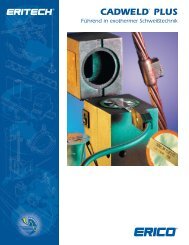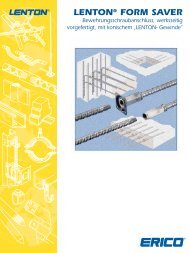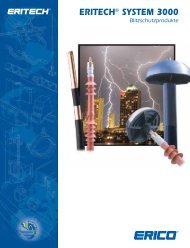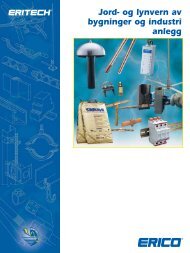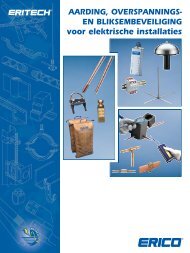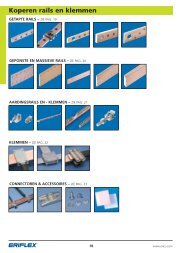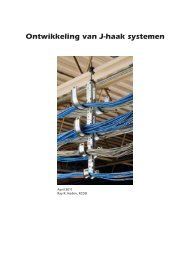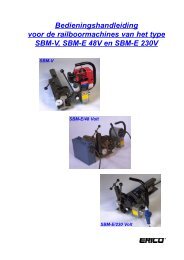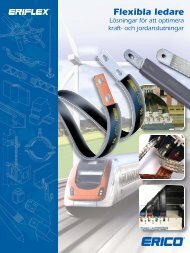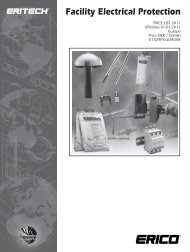Coordinated Facility Protection Catalog - Erico
Coordinated Facility Protection Catalog - Erico
Coordinated Facility Protection Catalog - Erico
You also want an ePaper? Increase the reach of your titles
YUMPU automatically turns print PDFs into web optimized ePapers that Google loves.
Surge <strong>Protection</strong> And Surge Ratings<br />
The stress, which an SPD will experience under surge<br />
conditions, is a function of many complex and interrelated<br />
parameters. These include:<br />
- Location of the SPD(s) within the structure – are they<br />
located at the main distribution board or within the<br />
facility at secondary board, or even in front of the<br />
end-user equipment?<br />
- Method of coupling the lightning strike to the facility –<br />
for example, is this via a direct strike to the structure’s<br />
LPS, or via induction onto building wiring due to a<br />
nearby strike?<br />
- Distribution of lightning currents within the structure –<br />
for example, what portion of the lightning current enters<br />
the earthing system and what remaining portion seeks<br />
a path to remote grounds via the power distribution<br />
system and equipotential bonding SPDs?<br />
- Type of power distribution system – the distribution<br />
of lightning current on a power distribution system is<br />
strongly influenced by the grounding practice for the<br />
neutral conductor. For example, in the TN-C system with<br />
its multiple earthed neutral, a more direct and lower<br />
impedance path to ground is provided for lightning<br />
currents than in a TT system.<br />
- Additional conductive services connected to the facility<br />
– these will carry a portion of the direct lightning<br />
current and therefore reduce the portion which flows<br />
through the power distribution system via the lightning<br />
equipotential bonding SPD.<br />
- Type of waveshape – it is not possible to simply consider<br />
the peak current which the SPD will have to conduct,<br />
one also has to consider the waveshape of this surge. It<br />
is also not possible to simply equate the areas under the<br />
current-time curves (also referred to as the action integral)<br />
for SPDs under different waveshapes.<br />
Many attempts have been made to quantify the electrical<br />
environment and “threat level” which an SPD will<br />
experience at different locations within a facility. The<br />
IEC standard on lightning protection, IEC 62305-4<br />
“<strong>Protection</strong> against lightning - Part 4: Electrical and<br />
electronic systems within structures” has sought to address<br />
this issue by considering the highest surge magnitude<br />
which may be presented to an SPD based on the lightning<br />
protection level (LPL) being considered. For example, this<br />
standard postulates that under a LPL I the magnitude of a<br />
direct strike to the structure’s LPS may be as high as 200 kA<br />
10/350. While this level is possible, its statistical probability<br />
of occurrence is approximately 1%. In other words, 99%<br />
of discharges will be less than this postulated 200 kA peak<br />
current level.<br />
An assumption is made that 50% of this current is<br />
conducted via the building’s earthing system, and 50%<br />
returns via the equipotential bonding SPDs connected to<br />
www.erico.com 15<br />
a three wire plus neutral power distribution system. It is also<br />
assumed that no additional conductive service exists. This implies<br />
that the portion of the initial 200 kA discharge experienced by<br />
each SPD is 25 kA.<br />
Simplified assumptions of current dispersion are useful in<br />
considering the possible threat level, which the SPD(s) may<br />
experience, but it is important to keep in context the assumptions<br />
being made. In the example above, a lightning discharge of<br />
200 kA has been considered. It follows that the threat level to<br />
the equipotential bonding SPDs will be less than 25 kA for 99%<br />
of the time. In addition, it has been assumed that the waveshape<br />
of this current component through the SPD(s) will be of the<br />
same waveshape as the initial discharge, namely 10/350, while<br />
in reality the waveshape have been altered by the impedance<br />
of building wiring, etc.<br />
Many standards have sought to base their considerations on field<br />
experience collected overtime. For example, the IEEE ® guide<br />
to the environment C62.41.1 and the recommended practice<br />
C62.41.2 present two scenarios of lightning discharge and<br />
different exposure levels under each of these depending on the<br />
location where the SPD is installed. In this standard, Scenario II<br />
depicts a direct strike to the structure, while Scenario I depicts<br />
a nearby strike and the subsequent conducted current into a<br />
structure via power and data lines. The highest surge exposure<br />
considered feasible to an SPD installed at the service entrance to a<br />
facility under Scenario I is 10 kA 8/20, while under Scenario II it is<br />
considered to be 10 kA 10/350 (exposure Level 3).<br />
From the above, it is apparent that the selection of the<br />
appropriate surge rating for an SPD depends on many complex<br />
and interconnected parameters. When addressing such<br />
complexities, one needs to keep in mind that one of the more<br />
important parameters in selecting an SPD is its limiting voltage<br />
performance during the expected surge event, and not the<br />
energy withstand which it can handle.<br />
LPZ 0A<br />
LPZ 0B<br />
Lightning terminal<br />
collection volume<br />
Shielded<br />
Room<br />
LPZ 2<br />
LPZ 1<br />
<strong>Protection</strong> zones defined by specific product application.<br />
LPZ 0A



